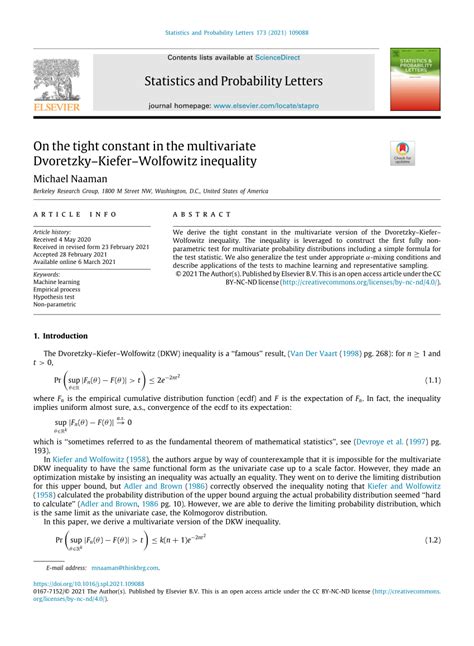Dvoretzky's theorem

In mathematics, Dvoretzky's theorem is an important structural theorem about normed vector spaces proved by Aryeh Dvoretzky in the early 1960s, answering a question of Alexander Grothendieck. In essence, it says that every sufficiently high-dimensional normed vector space will have low-dimensional … See more For every natural number k ∈ N and every ε > 0 there exists a natural number N(k, ε) ∈ N such that if (X, ‖·‖) is any normed space of dimension N(k, ε), there exists a subspace E ⊂ X of dimension k and a positive definite See more In 1971, Vitali Milman gave a new proof of Dvoretzky's theorem, making use of the concentration of measure on the sphere to show that a random k-dimensional subspace satisfies … See more • Vershynin, Roman (2024). "Dvoretzky–Milman Theorem". High-Dimensional Probability : An Introduction with Applications in … See more WebThe Non-Integrable Dvoretzky Theorem holds for n= 2, see [13, 11, 12] and a proof in Section 4. The main goal of this note is to construct counter-examples for greater values of n; namely, in Sections 2 and 3 we show that the Non-Integrable Dvoretzky Theorem does not hold for all odd nand also for n= 4. More formally: Theorem 2. Let n 3 be an ...
Dvoretzky's theorem
Did you know?
Web2. The Dvoretzky-Rogers Theorem for echelon spaces of order p Let {a{r) = {dp)} be a sequence of element co satisfyings of : (i) 44r)>0 for all r,je (ii) a http://www.math.tau.ac.il/~klartagb/papers/dvoretzky.pdf
Webof the nonlinear Dvoretzky problem: one can keep the statement of Dvoretzky’s theorem unchanged in the context of general metric spaces, while interpreting the notion of dimension in the appropriate category. Thus one arrives at the following question. Question 1.3 (The nonlinear Dvoretzky problem for Hausdor dimension). Given >0 WebJan 1, 2004 · In this note we give a complete proof of the well known Dvoretzky theorem on the almost spherical (or rather ellipsoidal) sections of convex bodies. Our proof follows Pisier [18], [19]. It is accessible to graduate students. In the references we list papers containing other proofs of Dvoretzky’s theorem. 1. Gaussian random variables
Webtheorem of Dvoretzky [5], V. Milman’s proof of which [12] shows that for ǫ > 0 fixed and Xa d-dimensional Banach space, typical k-dimensional subspaces E ⊆ Xare (1+ǫ)-isomorphic to a Hilbert space, if k ≤ C(ǫ)log(d). (This … WebSep 2, 2010 · In this paper we prove the Gromov–Milman conjecture (the Dvoretzky type theorem) for homogeneo us polynomials on Rn, and improve bounds on the number …
WebIn mathematics, Dvoretzky's theorem is an important structural theorem about normed vector spaces proved by Aryeh Dvoretzky in the early 1960s,[1] answering a question of …
WebAn extension of Krivine's theorem to quasi-normed spaces A. E. Litvak; 15. A note on Gowersí dichotomy theorem Bernard Maurey; 16. An isomorphic version of Dvoretzky's theorem II Vitali Milman and Gideon Schechtman; 17. Asymptotic versions of operators and operator ideals V. Milman and R. Wagner; 18. Metric entropy of the Grassman manifold ... ooh inflationWebJul 1, 1990 · Continuity allows us to use results from the theory of rank statistics of exchangeable random variables to derive Eq. (7) as well as the classical inverse … ooh is atl or btlWebTo Professor Arieh Dvoretzky, on the occasion of his 75th birthday, with my deepest respect Supported in part by G.I.F. Grant. This lecture was given in June 1991 at the Jerusalem … ooh i so want to crosswordWebIn mathematics, Dvoretzky's theorem is an important structural theorem about normed vector spaces proved by Aryeh Dvoretzky in the early 1960s, [1] answering a question … ooh inventory finderWebSep 29, 2024 · Access options Get access to the full version of this content by using one of the access options below. (Log in options will check for institutional or personal access. ooh investor relationsWebThe Dvoretzky–Kiefer–Wolfowitz inequality is one method for generating CDF-based confidence bounds and producing a confidence band, which is sometimes called the … ooh i so want toWebThe relation between Theorem 1.3 and Dvoretzky Theorem is clear. We show that for dimensions which may be much larger than k(K), the upper inclusion in Dvoretzky Theorem (3) holds with high probability. This reveals an intriguing point in Dvoretzky Theorem. Milman’s proof of Dvoretzky Theorem focuses on the left-most inclusion in (3). ooh information